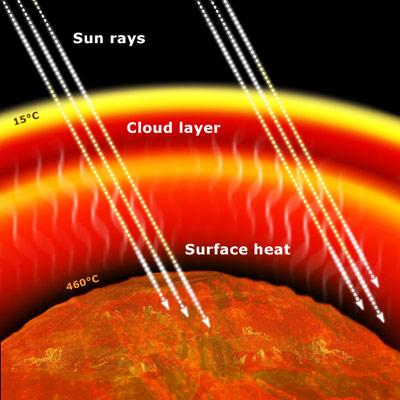Presence of water and water evaporation on planet Venus
Just like the Earth, Venus used to have large amounts of water. In fact, this water came from volcanism.
However, it has been completely evaporated due to the proximity of Venus to the Sun. Venus is 1.38 times closer to the Sun than the Earth, and so receives almost 2 times (1.91) the energy flux that the Earth receives.
High temperatures provoke the evaporation of water. This is exacerbated by the fact that the boiling point of water depends on atmospheric pressure: at low pressure, water boils before 100°C, facilitating evaporation.
It is possible that the pressure was lower, because degassing started later. And so the greenhouse effect began. Ultraviolet radiation then took over, making the greenhouse effect permanent.
Water vapour is a gas that hugely increases the greenhouse effect – perhaps contributing 25 % to the Venusian greenhouse problem, and it is probably the origin of the runaway effect on the Venusian climate.
UV radiation dissociated water vapour molecules into hydrogen and oxygen. Since hydrogen is lighter, it was rapidly (over 500 million years) removed by the solar wind; lost to space forever. The oxygen produced at the same time remained on the planet and combined with rocks in the crust, easily due to high surface temperatures.
Runaway greenhouse effect on planet Venus.
Once all the water was gone, carbon dioxide (CO2) contributed to the greenhouse effect. On Earth it is leached by rain and transported by surface water to the oceans where it is transformed into carbonate (shells and chalk). But not on Venus! The CO2 remains in the atmosphere where it continually contributes to the greenhouse effect.
In this way, Venus lost, over the course of 1 to 2 billion years, the water that it had gained from degassing over 500 million years.



